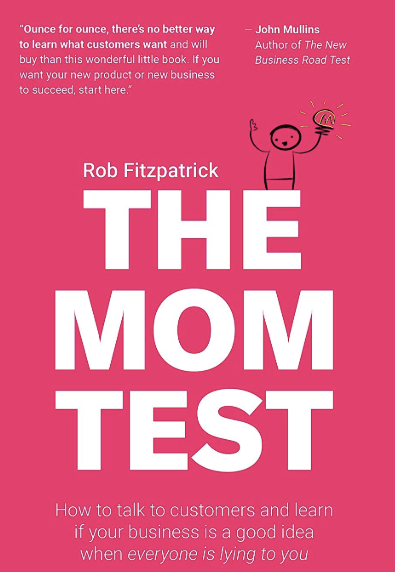Validating Your Ideas With Customers
Do you know what is the most common killer of new businesses?
You’d think the top killer would be something to do with investor fights or a poor quality product/service.
Nope, it’s a founder creating a technically-capable-yet-still-not-valuable solution.
They solved an irrelevant customer problem.
This is devastating in two ways:
1. The founders built something that wasn’t desirable, that didn’t meet a High Value Job, or that applied to a painfully niche group of customers.
2. The business actually did a good job of solving the problem, and that still didn’t lead to a sustainable business.
In their frantic dedication to making something that works, they missed Paul Graham’s golden rule: Sell something people want.
They didn’t validate their assumptions with their customers, and the longer they worked on their ideas, the more painful this reality check will be.
It doesn’t have to be this way.
As a founder trying to improve their business ideas, you get to process some mixed news:
· We can avoid this killer by validating ideas right now
· We won’t know how long this process will take
· Validation is a learnable skill
· Validation is a bit uncomfortable
· We might discover new ideas that we’d never have had on our own
· We’ll need to leave our egos at the door
· This skill will come in handy for every business we build in the future
· The best book on validation is a really enjoyable book to read
Let’s have a closer look at the validation process, the mental and technical aspects and some good frameworks for getting the truth out of your customers.
If You Hit This Sign, You Will Hit That Bridge
This sign is blunt, loud and direct – and it’s trying to help you.
If there’s a problem, the metal sign is going to be a lot softer on your vehicle than that reinforced concrete bridge.
We want one of these signs for our business ideas – a fair and accurate test that shows us if there’s an issue with our assumptions, and in a way that gives us time to adjust our course.
The best source of truth for these is our customers themselves; they can tell us about themselves, their preferences, their dealbreakers and their quirks.
But they won’t say it quite that honestly, we’re going to have to deduce the truth for ourselves, by running simple and helpful customer interviews.
Principles For Approaching Interviews
Good customer interviews are a goldmine, but it’s also easy to bias an interview and misread the truth.
Here are some helpful principles to keep in mind;
· Hold your ideas loosely so that you can be a good listener.
If you’ve already made up your mind, you’ll miss both the red flags as well as the interesting possibilities that customers are trying to show you.
· Write your principles in pen and your business model in pencil.
No customer can tell you what to care about, but they might have some good suggestions for how to set up the business itself.
Stick to your beliefs, but don’t get attached to the specifics of your products/services.
· It’s hard, but shouldn’t be THAT hard to find customers.
Customers are out there somewhere, naturally congregating and looking at potential solutions.
If you can’t find anyone to interview, why would they be a good customer base for a business?
· Emotional labour isn’t the same as the rest of your To-Do List.
Interviews are exciting and a bit confronting, so schedule them for times when you’re ready for emotional labour.
Probably not when either of you are tired or hungry.
· Reward yourself for the process, for the attempt, not the result.
An experiment is a good use of your time, irrespective of what you find.
Treat yourself, you’re going to need to do more of them so you might as well make them a pleasant experience.
· We want to measure interest, not create interest.
An entrepreneur wants to find a deep pool of good customers.
Don’t push for a sale, twisting arms doesn’t scale over time.
Some clever businesses can generate interest out of (seemingly) nowhere, but for new businesses you want to tap into existing customer interest or market demand.
· This is for your benefit, why cheat yourself?
As Steve Blank put it: “Cheating on customer discovery interviews is like cheating in your parachute packing class”.
· People are more honest about their past behaviour than their future behaviour.
It’s not that they intend to lie, it’s just that facts are easier to describe than predictions about what they would do in the future.
They’re also not trying to protect your feelings when talking about the past, and don’t have to admit “actually I’d never buy what you’re selling”.
· You’re allowed to bin, shelve or rework your ideas.
The only true issue is denying there’s a problem because you want it to succeed.
· Downhill is easier than uphill.
Seth Godin has a great analogy about pushing ideas up and down hills:
“If you can think about how hard it is to push a business uphill, particularly when you're just getting started, one answer is to say: ‘Why don't you just start a different business you can push downhill?’
Pivot or Persevere?
That last principle from Seth Godin raises an interesting dilemma for entrepreneurs – do they need to pivot their ideas or persevere through hard times and uncertainty?
There are so many stories of entrepreneurs who found success by pivoting their business ideas, suddenly finding a golden opportunity by changing their market or their menu.
There are so many stories of entrepreneurs who found success by persevering with their business ideas, by blocking out bad news or by pushing through hard times.
And the problem is, taking this “good advice” in the wrong circumstances leads to disaster.
Pivot when you need to persevere, and you miss out on a golden opportunity.
Persevere when you need to pivot, and you stay stuck in a rut, often at great personal expense.
Customer interviews help us understand which situation we are in.
Is there a good market and a good opportunity, that will take longer to develop?
Are customers asking for products and services that we don’t currently have, but could offer within a few months from now?
What parts of the ideas do customers love?
What parts of the model could customers live without?
Two Types Of Tests
There are two types of test that offer tremendous insights at this stage:
1. Customer Interviews, which create clarity on things like Jobs To Be Done, Value Propositions and Customer-Problem Fit.
Our first interviews are focused on customers telling us about their wants, needs, dilemmas and buying behaviours.
Subsequent interviews might then let customers play/interact with our prototypes, to see how they behave and what they think.
2. Prototypes and Pretotypes, which create clarity on things like Customer-Problem Fit, Product-Solution Fit, Customer Journey Mapping, and help us iterate our ideas in a short space of time.
Some of these are for your team’s benefit, and some might be used with customers.
Some might even become Minimum Viable Products, where they can genuinely give customers what they’re looking for.
Right now, we’re focused on Customer Interviews, which will help us know what to build in the Prototype and Pretotype stage.
The Mom Test
The best book on customer interviews is called The Mom Test by Rob Fitzpatrick.
It’s short, it’s funny, it’s easy to access online.
Best of all, the main ideas in the book are in the first half, so you only need to read 40-50 pages or 1.5 hours of the audiobook to get 80% of the benefit.
The book outlines the need for high quality data – good insight from the right people, rather than false signals from well-meaning people who aren’t our customer.
e.g. your mum, who wants the best for you, but might not have a High Value Problem or Job To Be Done in your field.
In her attempts to be supportive, she might end up sending you down the wrong path.
Here are a few of my favourite quotes from the book:
“Trying to learn from customer conversations is like excavating a delicate archaeological site.
The truth is down there somewhere, but it’s fragile.
While each blow with your shovel gets you closer to the truth, you’re liable to smash it into a million little pieces if you use too blunt an instrument.”
“We go through the futile process of asking for opinions and fish for compliments because we crave approval.
We want to believe that the support and sign-off of someone we respect means our venture will succeed.
But really, that person’s opinion doesn’t matter.
They have no idea if the business is going to work.
Only the market knows.
You’re searching for the truth, not trying to be right.
And you want to do it as quickly and cheaply as possible.”
“Learning that your beliefs are wrong is frustrating, but it’s progress.
It’s bringing you ever closer to the truth of a real problem and a good market.
The worst thing you can do is ignore the bad news while searching for some tiny grain of validation to celebrate.
You want the truth, not a gold star.”
It can be hard to read these, because it feels like Rob has written this book specifically about you.
But he’s right.
His suggestion is to approach people in a friendly and casual way, rather than in a contrived market research group, and enquire about what they’re looking for or what they’ve bought in the past.
“If they haven’t looked for ways of solving [their problem] already, they’re not going to look for (or buy) yours.”
You don’t need to tell them what you’re working on, in fact it’s important that you don’t, because it makes things more complicated.
That’s because we only want to hear from people who are genuinely in the market, and you’ll know that they’re in the market because they’ve been trying to find a solution.
“It boils down to this:
You aren’t allowed to tell them what their problem is, and in return, they aren’t allowed to tell you what to build.
They own the problem, you own the solution.”
Finally, the way of separating empty words from genuine enthusiasm is by looking for two tangible clues:
“Outcome of customer meetings should be commitment and advancement;
Commitment — they are showing they’re serious by giving up something they value such as time, reputation, or money.
Advancement — They are moving to the next step of your real-world funnel and getting closer [to] purchasing.
The more they’re giving up, the more seriously you can take what they’re saying.”
The other brilliant part of the book is his breakdown of good and bad questions.
He dissects the most common or obvious questions, and reveals what makes them helpful or unhelpful for your interview.
Read those pages (Chapter 3) and you’ll feel instantly equipped to design some interview questions that are 3x better than what you’d use today.
Practical Tips For Customer Interviews
Once you’ve decided that you genuinely want to hear from real customers, there are a few tricks you can use to make the most of these insights:
· Go in pairs, it’s much easier to have a lead person asking questions and a second person asking for clarifications. It’s really hard to be a good interviewer, note taker and perceptive listener at the same time. You also get the benefit of having someone to debrief with after the conversations.
· With permission, record the conversations – even if it’s just on your phone. You can double-check phrasing and listen for anything you missed in the moment.
· Five to seven honest conversations is a good sample size. Less than five is liable to be skewed by one or two passionate people. You should have a decent read on the situation by seven. If you can’t find five honest customers to interview, it’s a sign that you’re not yet familiar enough with this market.
· Michael Bungay Stanier has this great question, where he asks “and what else?” after the other person’s responses. It can yield some golden answers, pushing people past their first (and often predictable) answer, revealing some new truths.
· Small incentives are a nice way to thank people for their time, but don’t go too large or you’ll attract people who aren’t actually representative of your market. We once had 2/3rds of respondents answer our questions without ever taking interest in what we were working on, they just spoke to us because we were offering Gold Class movie tickets.
Process vs Result
The hardest part of validation is deciding to commit to a good process rather than frantically searching for a good result.
We so often want to be right, or feel stuck until we hear some reassurance, and therefore jump at anything that sounds like positive feedback.
Discipline is designing tests that are allowed to fail – setting targets that are fair but not ridiculously easy.
Discipline is sitting on your hands, trying not to blurt out all of your ideas.
Discipline is being a good interviewer rather than a good salesperson, letting the conversation go their way instead of yours.
And this discipline is what’s going to save you from investing heavily in the wrong thing.
If nothing else, ask “What would future me want me to do now?”.
The most likely answer is “to take the time to properly understand my customers”.
So to recap:
· Decide that you WANT to validate your ideas, that validation is helpful and not a nuisance to be avoided.
· Read The Mom Test, specifically the first five chapters.
· Using The Mom Test, draft a list of good interview questions for your industry.
· Casually talk to 5-7 people who represent your market, focusing on them and their behaviours, not on you and how wonderful your ideas are.
· Listen for stories that validate or update your assumptions.
· Create an opportunity for commitment and advancement, like offering a follow-up conversation, an introduction to another person or joining your mailing list for when you have relevant announcements/offers.
· Measure how many people take you up on your offers, versus the ones who have been polite but might not be your real customers.
For further reading, we recommend How To Conduct User Interviews, the d.school Empathy Fieldguide, and Envato’s Techniques For Empathy Interviews In Design Thinking.






